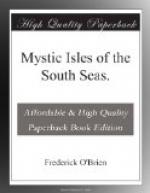Ariioehau Amerocarao, commonly known as Tetuanui Tavana, or Monsieur le Chef de Mataiea, Tetuanui, and his wife, Haamoura, were the salt of the earth. The chief was a large man, molded on a great frame, and very corpulent, as are most Polynesians of more than thirty years. He was about sixty, strong and sweet by nature, brave and simple. His vahine was very stout, half blind from cataracts, but ever busied about her household and her guests. As chief and roadmaster of his district, Tetuanui received a small compensation, but not enough for the wants of his dependents, so a few paying white guests were sent to him by Lovaina. The house was set back from the Broom Road in a clearing of a wood of cocoanuts, breadfruits, badamiers, and vi-apples. The father of Haamoura had given the land to his daughter, and they had built on it a residence of two high stories, with wide verandas.
The chief and his wife had no children, but had adopted twenty-five. They had brought most of these to manhood and womanhood, and many were married. Perhaps their care, dots for the daughters, and estates for the sons, had made the parents poor. One was the blood son of Prince Hinoe, and was now a youth, and worked about the plantation of the chief. His christened name was Ariipaea Temanutuanuu Teariitinorua Tetuanui a Oropaa Pomare. He was a prince and very handsome and gentle, but he gathered the leaves from the volunteer lawn for the horses. There was an atmosphere of affection and happiness about the home I have not sensed more keenly anywhere else.
The Duke of Abruzzi’s photograph and one of the Italian war-ship Liguria, were on a wall in the drawing-room, with others of notable people whom the chief had entertained. He himself wore the cross of the Legion of Honor, which had been presented to him in Paris when he visited there many years before.
The house was raised ten feet from the earth, and the ground below was neatly covered with black pebbles from the shore. Shaded by the veranda-floors, which formed the ceilings of their open rooms, the family sat on mats, and made hats, sewed, sang, and chatted. They laughed all day. A dozen children played on the sward where horses, ducks, geese, chickens, and turkeys fed and led their life. When rice or corn was thrown to them, the mina-birds flocked to share it. These impudent thieves pounced on the best grains, and though the chickens fought them, they appeared to be afraid only of the ducks. These hated the minas, and pursued them angrily. But the minas can fly, and, when threatened, lazily lifted themselves a few feet out of reach of the bills, and returned when danger was over.
The chief’s plantation extended from the sea to the mountain, altogether about ten acres, which in Tahiti is a good-sized single holding. Cocoanuts, breadfruit, limes, oranges, badamiers, mangoes, and other trees made a dense forest, and a hectare or more was planted with vanilla-vines that grew on the false coffee of which hedges were usually made. A hundred yards away a stream meandered toward the sea, and there women of the household sat and washed clothes.




